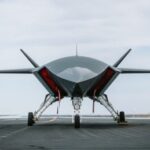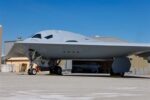Key Points
Durham University unveiled T-STAR, a swarm trajectory-planning system that lets UAV groups fly faster and safer through cluttered environments.
The peer-reviewed paper (IEEE Transactions on Intelligent Transportation Systems) details a time-optimal planner using Model Predictive Contour Control, differential flatness, virtual forces, and event-triggered deconfliction.
Lab and simulation tests show shorter mission times and smoother trajectories versus conventional methods.
If matured, T-STAR could benefit search & rescue, ISR, logistics, and contested military operations, but EW resilience, GNSS denial, and scaling beyond dozens of drones remain open issues.
The advance sits alongside a fast-moving field of swarm planners (e.g., Primitive-Swarm, Optimal Virtual Tube) and growing battlefield use of swarms.
Why This Matters
Drone swarms are moving from demo reels to the battlespace. Durham University’s T-STAR proposes a time-optimal approach to keep a formation moving quickly without trading away safety—exactly the trade-space that usually breaks swarms in urban canyons, forests, or rubble. The university’s release highlights faster task completion and smoother paths; the media coverage is consistent, but the technical novelty is anchored in the IEEE T-ITS paper.
What T-STAR Actually Is
T-STAR (Time-optimal Swarm Trajectory planning for Aerial Robots/UAVs) computes collision-free, time-optimal trajectories for each quadrotor in a swarm while enforcing safe separation and formation behavior. According to the authors’ repository record, the planner uses:
Model Predictive Contour Control (MPCC) to track time-optimal paths,
Differential flatness of quadrotor dynamics to simplify constraints and computation,
Virtual attractive/repulsive forces for flocking, and
Event-triggered re-planning for fast deconfliction when conflicts arise.
The university notes real-time inter-drone information sharing so neighbors can instantly adjust paths—functionally moving “like a flock” rather than rigidly pre-scripted routes.
Evidence So Far: Simulations and Lab Trials
Durham reports that in simulations and lab experiments, swarms using T-STAR finished tasks faster with smoother flight paths than baseline methods, avoiding the stop-and-go behaviors that plague many swarms in obstacles. The PR and trade-press coverage repeat the same findings and attribute the work to a team including Junyan Hu, Farshad Arvin, Fatemah Rekabi-Bana, Mohsen Zahmatkesh, and Honghao Pan. The journal citation confirms authorship, venue, and methods.
Journal reference: Pan, H., Zahmatkesh, M., Rekabi-Bana, F., Arvin, F., & Hu, J., “T-STAR: Time-Optimal Swarm Trajectory Planning for Quadrotor Unmanned Aerial Vehicles,” IEEE Trans. on Intelligent Transportation Systems, 26(8), 12532–12547 (2025).
Military & Security Use Cases (Expert Analysis)
ISR & Sensors: Fast, coordinated area coverage and multi-angle EO/IR collection; time-optimal planning helps finish mapping/target search before adversary C-UAS reacts.
Missiles & Munitions / Loitering Effects: A T-STAR-like planner could dynamically assign interceptors/strikers within the swarm while preserving safe separation, relevant to munition swarms or mixed ISR-strike packages. (Analyst assessment)
Comms & C2: T-STAR assumes real-time inter-drone exchange—practically a tactical mesh. In conflict zones where AI-swarms are already appearing (e.g., Ukraine), resilient comms and autonomy at the edge are essential.
Disaster Response / Civil Security: Precise, fast pathing through debris fields for SAR, wildfire plume mapping, and aid drops.
Where It Fits vs. Other Swarm Planners
The field has sprinted in 2025 with multiple credible approaches:
Primitive-Swarm: ultra-lightweight, decentralized, asynchronous replanning with a motion-primitive library and sub-millisecond selection—scaled in sim to 1,000 robots. Great for scale, with different optimality guarantees.
Optimal Virtual Tube: real-time planner using affine approximations to keep computational cost O(nₜ) and blend reactive and long-horizon behavior.
T-STAR’s niche is time-optimality under rich dynamics/constraints with event-triggered deconfliction, which can translate into faster mission completion in dense clutter. (Synthesis based on the T-ITS record.)
Gaps, Risks, and What to Watch (Critical View)
EW & C-UAS pressure: Real-time inter-drone comms invite jamming, deception, and traffic overload. Robustness to GNSS denial and RF jamming isn’t detailed in public materials; operationalizing T-STAR will require GNSS-independent state estimation, spectrum agility, and degraded-comms modes. (Expert assessment grounded in field realities.)
Scale & heterogeneity: The public tests emphasize lab/sim. Proving dozens→hundreds of heterogeneous drones outdoors—under wind, multipath, and adversarial interference—is the hurdle every swarm stack faces.
Safety certification & ROE: Integrating time-optimal swarm planners into C2/C4ISR stacks and airspace rules (e.g., MIL standards, national UTM) will take methodical validation. (Expert assessment.)
Benchmark transparency: Releasing code/data or standardizing head-to-head benchmarks (T-STAR vs. Primitive-Swarm/OVT) would help quantify gains beyond press-release claims.
Bottom Line
Durham’s T-STAR is real, peer-reviewed work that squarely attacks the speed-vs-safety trade-off in swarm flight. It deserves attention from defense programs exploring cooperative ISR and autonomous strike—with the caveat that EW-hardening and at-scale field trials will decide whether it leaves the lab.








